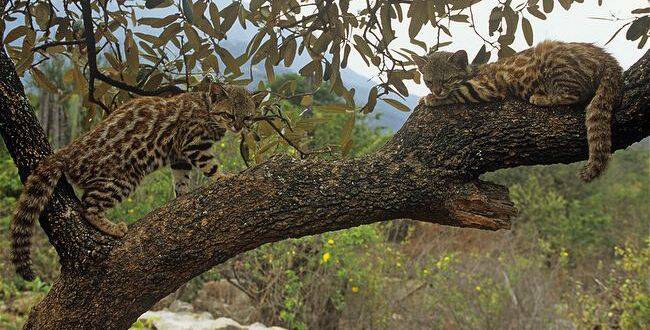Leopardus colocolo
IUCN
LCBasic Information
Scientific classification
- name:Leopardus colocolo
- Scientific Name:Leopardus colocolo,Pampas Cat,South American savannah cat, savannah cat
- Outline:Carnivora
- Family:Felidae Ocelothrix
Vital signs
- length:42-79cm
- Weight:3-3.7kg
- lifetime:9-16 years
Feature
There is a long mane on the back up to 7 cm long
Distribution and Habitat
Distributed in southwestern South America, Ecuador, Peru, Brazil, Bolivia, Chile, Paraguay, Uruguay and Argentina. Also distributed in southern Colombia.
Lives on grasslands. In addition to lowland rainforests, it inhabits moist forests, open woodlands, swamps, and scrub in southwestern South America, including the cold and barren Patagonia region.
Appearance
The head and body length of the South American steppe ocelot is 42-79 cm, the tail length is 22-33 cm, and the weight is 3-3.7 kg. There is a long mane on the back, up to 7 cm long, which immediately stands upright when it is nervous, creating an appearance that is much larger than its actual size. The overall appearance of the South American steppe ocelot looks like a domestic cat wearing a thick fur coat. However, its body size is still larger than that of a domestic cat. Its limbs are not long, but they are thick. The tail is about less than half the length of the body, like a fluffy brush. The head is small, the face is relatively wide, and the muzzle is relatively short. They have a pair of beautiful amber eyes, and there is often a circle of white hair around the nose and eyes. The ears are pointed and the backs of the ears are dark, but the steppe ocelots living in the northern regions usually have a white spot behind the ears like most cats. Two conspicuous stripes extend from
Details
Pampas Cat (scientific name: Leopardus colocolo) is also known as Pampas Cat, with 8 subspecies.

Pampas Cat is mainly active at night, is an expert climber, very ferocious, and very agile. It mainly preys on small mammals, mainly rodents and guinea pigs, but also catches ground-dwelling birds and even poultry, and also preys on lizards and larger insects.
The South American steppe tiger cat reaches sexual maturity at the age of two, with a breeding period from April to July, a gestation period of 80-85 days, and 1-3 kittens each time. The average lifespan is 9 years, and the longest is 16 years.
South American steppe tiger cat In Uruguay, the South American steppe tiger cat was once declared extinct, and perhaps a small number of survivors continue to survive tenaciously. The species is also a victim of the fur trade. In view of their increasingly scarce numbers, the World Trade Organization issued a decree in 1987 to stop the international fur trade of the South American steppe tiger cat. Today, the situation of South American steppe cats varies from place to place. For example, in Peru, they are listed as "endangered"; in Paraguay, they are listed as "rare". Argentina, Bolivia, Chile and Paraguay have all banned the hunting of them, and in Peru, their hunting is also regulated. Between 1976 and 1979, 78,000 skins of South American steppe cats were exported. In 1980, they were protected and the fur trade was banned.
Listed in the 2016 Red List of Endangered Species of the World Conservation Union (IUCN) ver 3.1 - Near Threatened (NT).
Protect wildlife and eliminate game.
Maintaining ecological balance is everyone's responsibility!








